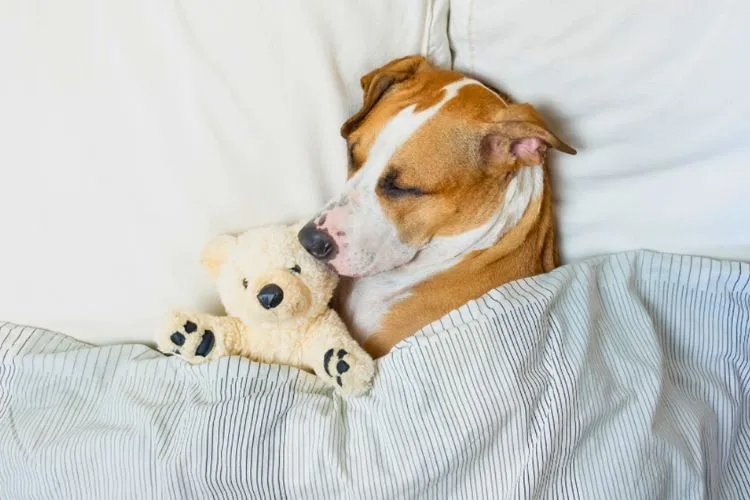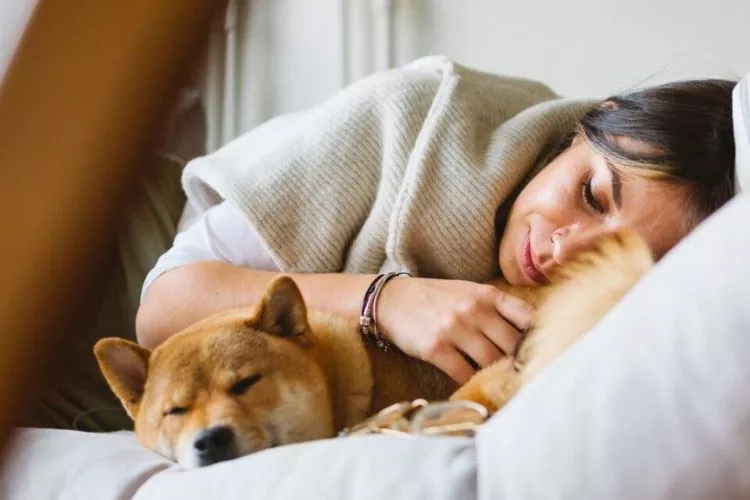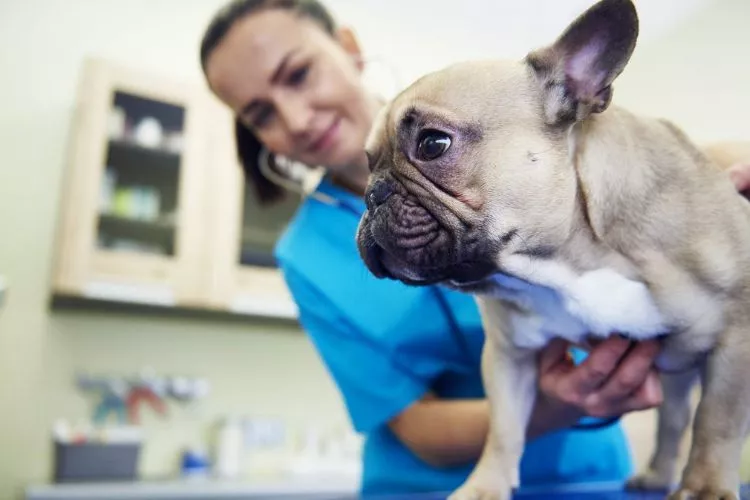Pet owners often notice their furry companions engaging in unusual sleeping positions. One example that sparks curiosity is when dogs appear to fall asleep sitting up. Is your pooch just overly tired?

Or could this be a sign of some underlying health issue? In this article, we’ll explore the reasons that lead to this peculiar behavior, drawing from insights provided by veterinarians and dog behavioral experts.
We’ll also uncover whether noticing your dog falling asleep in a sitting position warrants a visit to the vet or if it’s just another quirky canine characteristic that makes our pets all the more endearing. So, let’s delve into the dynamic world of dogs and their idiosyncratic sleeping patterns.
🐾 Why does my dog fall asleep sitting up?
Dog’s sleep patterns can be fascinating to study and can sometimes be a source of concern for their human companions. When dogs fall asleep while sitting up, there could be a few explanations, ranging from benign habits to more serious health concerns.
1. Comfort and Safety
Some breeds, like terriers and hunting dogs, were bred to be alert. As a result, these breeds may prefer to doze off sitting up to be ready to jump into action at a moment’s notice.
This posture can also make them feel safer, particularly in new or uncertain environments, as standing up quickly from a sitting position is faster than getting up from lying down.
2. Habits from Puppyhood
Puppies often fall asleep in whatever position they happen to be in when fatigue catches up with them. It’s incredibly common for puppies to fall asleep sitting or even standing! As they mature, most grow out of it, but some dogs may continue this into adulthood out of habit.

3. Health-related Issues
In some cases, a dog may fall asleep sitting up due to health-related issues. Dogs with joint problems or arthritis might find it easier to be in a sitting position rather than lying down. This is because the process of getting up after lying down can be uncomfortable for them.
Contacting your vet would be recommended if you observe additional symptoms of discomfort, like your dog limping, being unusually slow or hesitant with movements, whining, or displaying any other unusual behavior possibly indicating pain.
4. Sleep Disorders
Dog narcolepsy and cataplexy, though not common, can cause dogs to suddenly fall asleep while in upright positions. These are neurological disorders that can affect a dog’s sleep-wake cycle. They may appear to be awake one second and asleep the next.
Obesity can also cause what might be misinterpreted as your dog falling asleep in a sitting position. Dogs carrying extra weight may face difficulty finding a comfortable position to sleep in, leading them to fall asleep in what may seem to be unusual positions.
5. Aging
In aging dogs, sitting up, or even standing while sleeping, could be part of canine cognitive dysfunction (CCD) or dog dementia. Other symptoms of this disorder include disorientation, reduced interaction with humans or other pets, changes in sleep patterns, and house soiling.
As mentioned, if your dog has recently started falling asleep sitting up, and you’re seeing other behavior changes (excessive licking, pacing, not responding to commands that they used to respond to, seeming distant or confused), then it’s worth contacting your vet.
However, without other accompanying symptoms, it’s likely that your furry friend simply finds this position comfortable and secure. Always remember to observe their behavior closely and consult a vet if you notice any sudden changes or persisting problems.
🐾 Practical Tips for Monitoring Sleep Changes in Dogs
Keeping track of your dog’s sleep patterns can be crucial in early detection of potential health issues and ensuring their overall well-being. Here are some practical tips for monitoring sleep changes in your dog:

1. Keep A Sleep Log
A sleep log can be invaluable for monitoring any significant changes in your dog’s sleeping patterns. Document the times your dog falls asleep and wakes up, noting any changes in the duration and quality of their sleep.
Pay close attention to any deviation from their regular sleeping routine, such as more frequent naps, difficulty in waking up, or sudden insomnia.
2. Record the Sleep Patterns
Noticing when your dog sleeps can help identify abnormalities. If your dog is active and alert during the day and sleeps for approximately 8 to 10 hours a night, this is normal. A change in this routine might be an indication of a potential health issue or disorder.
A video camera or a device capable of recording their behaviors while you’re not around can help provide more detailed insights.
3. Monitor Their Sleeping Positions
Remember, the sleeping position of your dog can also indicate their health conditions. Dogs often sleep on their stomachs when they need to jump up quickly; they’re in the REM cycle of their sleep when they’re on their sides.
If they suddenly switch to a new sleep position, like always sleeping sitting up, it’s worth taking note.
4. Learn to Read Your Dog’s Body Language
An essential part of monitoring your dog’s sleep changes includes understanding the nuances of their body language. Unusual movements during sleep, frequent twitching, restlessness, or difficulty in settling down could possibly suggest discomfort or a health problem.
Signs of discomfort might also show when the dog tries to find its sleeping position; fidgeting and frequent position changes should be monitored.
5. Routine Vet Checkups
Regular veterinary checkups are an integral part of keeping your dog healthy. During these visits, discuss the observations from your sleep log. If needed, the vet should be able to provide further tests such as x-rays, blood tests, or even a referral to a neurologist or behavioral expert.
6. Act on Noteworthy Changes
Act promptly on any significant alterations. If your dog displays sudden changes in sleeping patterns, positions, or behaviors, it’s crucial to consult with your veterinarian sooner rather than later. Even slight adjustments might be early indicators of underlying health problems.
In conclusion, understanding and monitoring your dog’s sleep patterns will help you ensure your furry companion’s health and happiness. Remember — you know your dog best, so trust your instincts if you feel something isn’t quite right.
🐾 Improving Dog Sleep Hygiene: Enhancing Comfort and Sleep Quality
Just like humans, dogs also require a suitable environment and certain conditions to ensure a peaceful and restorative sleep. Here are several practical tips to improve your dog’s sleep hygiene:

1. Comfortable and Suitable Dog Beds
Invest in a bed that caters to your dog’s specific needs. Older dogs may require orthopedic beds to support their joints, while dogs with thick coats might prefer a cooler surface to sleep on.
The bed should be the appropriate size, allowing your pet to stretch out comfortably. Regularly cleaning the dog bed to ensure it’s free from dirt and parasites also contributes to a better sleep environment.
2. Create a Quiet and Peaceful Sleeping area
Dogs can be sensitive to noise, so try to provide a quiet space for them to sleep. If you live in a noisy area, consider white noise machines or soothing pet music to help drown out the disruptive sounds. Keeping their sleeping area in a low-traffic part of the house can also minimise disturbances.
3. Regular Exercise
Physical activities during the day help to ensure a good night’s rest. Regular walks, playtime and mental stimulation will help tire your dog out and promote better sleep.
Be mindful of the timing – intense playtime just before bed might make them overly excited, making it difficult for them to settle down.
4. Follow a Consistent Sleep Schedule
Dogs thrive on routine. Try to have consistent times each day for meals, exercise, and bedtime. This way, your dog’s internal body clock will get accustomed to this schedule, making them more likely to fall asleep at the appropriate bedtime.
5. Mind the Temperature
Just like humans, dogs too can have trouble sleeping if they are too hot or too cold. Extreme temperatures can disrupt their sleep. Ensure that their sleeping area is warm during winters and cool during the peak summer months.
6. Limit Late-night Snacking
Feeding your dog right before bedtime might lead to restlessness and digestive issues, disrupting their sleep. Try to ensure that your dog has finished eating a couple of hours before their bedtime to promote undisturbed slumber.
7. Manage Lighting
Some dogs sleep better in the dark, while others might get nervous. Observe your dog’s preference and adapt accordingly. If your dog gets anxious in complete darkness, consider using a soft night light or leaving a hallway light on.
By considering these tips, you will create an environment that enhances the quality and health of your dog’s sleep, which will ultimately lead to a healthier and happier pet.
Other dog behavioral related articles you may find useful: Do Rottweilers Growl when they’re Happy? | Why Is My Dog Panting?
🐾 When to Contact a Veterinarian: Recognizing Signs of Trouble
Knowing when to contact your vet is crucial in maintaining your dog’s health and well-being. Here’s a detailed collection of signs and symptoms that may indicate your dog needs medical attention:

- Changes in Eating or Drinking Habits: Significant changes in the amount your dog eats or drinks can be a cause for concern. A sudden lack of appetite, excessive eating or drinking, or difficulty swallowing can indicate serious problems.
- Dramatic Weight Changes: A sudden gain or loss in your dog’s weight, even while maintaining their regular diet and exercise, can be a sign of an underlying health issue, such as a metabolic disorder, digestive issues, or certain types of cancer.
- Unexplained Vomiting or Diarrhea: Occasional upset stomachs could be common in dogs, but repeated, chronic, or severe symptoms require a vet’s attention. These could indicate poisoning, blockages, or other severe health problems.
- Changes in Breathing: If your dog is having trouble breathing, panting excessively, or has a persistent cough, it might be a sign of heart disease, lung disease, or other respiratory issues.
- Behavioral Changes: Changes in your dog’s normal behavior or personality, such as sudden aggression, fear, or disorientation, should not be ignored. Also, any noticeable drop in your dog’s energy levels could indicate sickness.
- Difficulty Urinating: Struggling to urinate, urinating in the house, increased frequency or reduced amounts can be a sign of urinary tract infections, bladder stones, or kidney disease.
- Changes in Skin or Coat: Prolonged itching, scratching, changes in skin color, lumps, hair loss or changes in coat quality warrant a visit to the vet, as these could be symptoms of allergies, hormonal imbalances or skin diseases.
- Unexplained Pain or Discomfort: Limping, reluctance to move, changes in posture, or signs of distress like whimpering or growling can indicate pain or discomfort, possibly due to injury, arthritis, or other health issues.
- Changes in Sleep Patterns: If your dog is excessively tired, restless at night, or has other significant alterations in their sleep patterns, it could signal that something is wrong.
Remember, spotting these signs and symptoms early on can ensure prompt attention and treatment for your pet.
However, these signs are not exhaustive. If you observe any unusual behavior in your dog, always err on the side of caution and make an appointment with your vet.
Conclusion:
For a variety of reasons, dogs can exhibit peculiar sleep behaviors like falling asleep while sitting up. While it often pertains to their instinctive need for security and quick response to potential danger, sudden changes in sleep routines could be a sign of potential health issues.
Through consistent monitoring and applying practical tips in maintaining your pet’s sleep hygiene, you can ensure their overall wellness. And remember, always consult with your vet when confronted with unusual behaviors in order to give your dog a healthy, blissful slumber each night.
